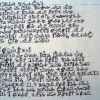“Is this guy a threat?” This was the question that officers at a nearby facility asked me after confiscating occult-related drawings from an inmate’s living area during a recent search. They wanted to know if the inmate could be part of a satanic cult. If so, could that make him a potential threat to the safety and security of officers and the facility? Did the artist “know what he was doing” or was he “just drawing pictures?” These are great questions, so I started digging for answers.
One of the more intriguing drawings (Illustration 1) that they sent to me was this:
Illustration 1
As I examined this drawing I noticed several occult symbols (Illustration 2):
A. The “Eye of Horus.”
B. Pentagram symbol.
C. Kamea or Square.
D. There are other symbols, but these became my focus.
Illustration 2
A. The “Eye of Horus” refers to the Egyptian god of Horus, who is usually represented as the falcon-headed god. It is a powerful symbol used in protection from evil. It was also used by Aleister Crowley, a Satanist who lived in America from 1915-1919.
B. The Pentagram is an ancient symbol with many meanings, but in this context it reflects the drawings occult meaning. Note that this is NOT the inverted Pentagram often seen as being a specific identifier for satanic use, like the following tattoo (Illustration 3):
Illustration 3
C. The Kamea or Square are each represented by a planet and are used by occult groups to transmit information using a complex method of creating symbols, known as “sigils” which may be seen in documents, graffiti or tattoos (Illustration 4 & 5):
Illustration 4
Illustration 5
The artist in question drew the Kamea of Sol (C) accurately, which went a long way to convincing me that the artist “knew what he was doing” and was not simply “drawing pictures.”
Looking at Illustration 6, I noticed the Pentagram, Eye of Horus and the Pyramids. As I looked closer, I also observed markings under the artists’ signature.
Illustration 6
Closeup (Illustration 7):
Illustration 7
I was able to determine that these markings were an ancient language: Thebian! An inmate in a correctional facility was using a language so ancient that we don’t even know its origins to send secret messages to the recipient of his drawings!
Illustration 8
Looking at additional drawings confirmed this fact and also produced additional symbols. Examining Illustration 9, I again saw the Pentagram (this time with the “life” Rune), Eye of Horus, Planetary Symbols, references to Pyramids and Stonehenge, and another message in the Thebian language.
Illustration 9
I was able to tell the concerned officials at the correctional facility that by taking the questioned documents as a whole, it could be determined that the artist was practicing (or wanted others to think that he practiced), a form of Paganism that pre-dates Christianity. The artist appeared to have a good working knowledge of the symbols that he was drawing. The correctional facility staff were just as surprised as I was that the artist was using Thebian to send additional information to the recipient of his material.
Armed with this information, more searches were conducted, and additional material was confiscated using the Thebian language to communicate. The takeaway message here is, don’t ever assume that because an inmate’s drawings or illustrations look harmless they actually are harmless. Scrutinize everything to the finest level of detail.
***
This article first appeared in American Jails magazine, May/June 2007 edition. It is reprinted here with the permission of the American Jail Association, www.aja.org.





















